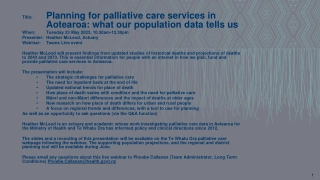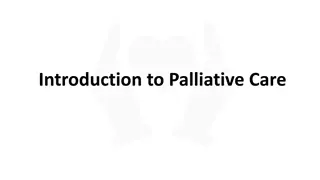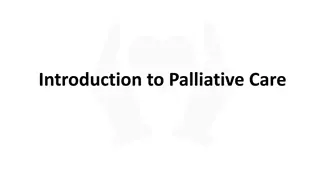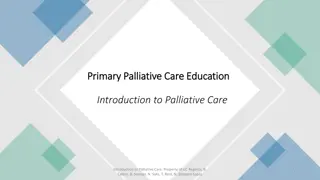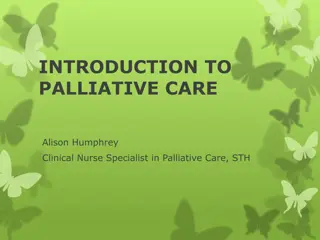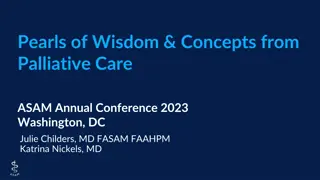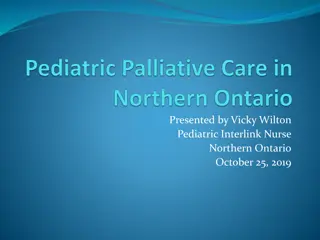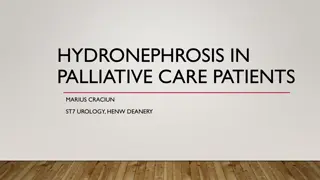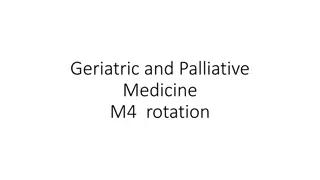Improved Palliative Care Model for End-of-Life Patients
Palliative care prescribing guidelines focusing on symptom control, reducing clinical variations, and improving quality of life for rural and remote patients. Discussion on the use of telehealth services and pain management strategies like opioid therapy and addressing agitation and restlessness in end-of-life care.
Download Presentation

Please find below an Image/Link to download the presentation.
The content on the website is provided AS IS for your information and personal use only. It may not be sold, licensed, or shared on other websites without obtaining consent from the author.If you encounter any issues during the download, it is possible that the publisher has removed the file from their server.
You are allowed to download the files provided on this website for personal or commercial use, subject to the condition that they are used lawfully. All files are the property of their respective owners.
The content on the website is provided AS IS for your information and personal use only. It may not be sold, licensed, or shared on other websites without obtaining consent from the author.
E N D
Presentation Transcript
Introduction to NLP Semantic Parsing
Semantic Parsing Converting natural language to a logical form e.g., executable code for a specific application Example: Airline reservations Geographical query systems
Stages of Semantic Parsing Input Sentence Syntactic Analysis Syntactic structure Semantic Analysis Semantic representation
Compositional Semantics Add semantic attachments to CFG rules Compositional semantics Parse the sentence syntactically Associate some semantics to each word Combine the semantics of words and non-terminals recursively Until the root of the sentence
Example Input Javier likes pizza Output like(Javier, pizza)
Example S -> NP VP {VP.Sem(NP.Sem)} t VP -> V NP {V.Sem(NP.Sem)} <e,t> NP -> N {N.Sem} e V -> likes { x,y likes(x,y) <e,<e,t>> N -> Javier {Javier} e N -> pizza {pizza} e
Semantic Parsing Associate a semantic expression with each node S: likes(Javier, pizza) N: Javier VP: x likes(x,pizza) Javier V: x,y likes(x,y) N: pizza pizza likes
Grammar with Semantic Attachments Example from Jurafsky and Martin
Using CCG (Steedman 1996) CCG representations for semantics ADJ: x.tall(x) (S\NP)/ADJ : f. x.f(x) NP: YaoMing YaoMing NP (S\NP)/ADJ ADJ YaoMing f. x.f(x) x.tall(x)> is tall S\NP x.tall(x) < S Tall (YaoMing)
CCG Parsing Example: https://bitbucket.org/yoavartzi/spf Tutorial by Artzi, FitzGerald, Zettlemoyer http://yoavartzi.com/pub/afz-tutorial.acl.2013.pdf
FrameNet Represents Events, relations, states, entities 1,195 semantic frames Example: Absorb_heat An Entity (generally food) is exposed to a Heat_source whose Temperature may also be specified. Generally, the Entity undergoes some sort of change as a result of this process. Bacon was frying in the pan, and a great heap of eggs already lay steaming on a plate. If it cooks at 400 for an hour, it 'll be nothing but a pile of ash! 1,774 frame-to-frame relations Links https://framenet.icsi.berkeley.edu/fndrupal/ http://naacl.org/naacl-hlt-2015/tutorial-framenet.html
Abstract Meaning Representation (AMR) http://amr.isi.edu/ Single structure that includes: Predicate-Argument Structure Named Entity Recognition Coreference Resolution Wikification [slide from Jonathan Kummerfeld]
Example Lassie ate four bones that she found. e / eat-01 Arg-0 Arg-1 Arg-0 a / animal f / find- 01 Arg-1 b / bone n / wiki: Lassie name Lassie 4 [slide from Jonathan Kummerfeld]
Example About 14,000 people fled their homes at the weekend after a local tsunami warning was issued, the UN said on its Web site (s / say-01 :ARG0 (g / organization :name (n / name :ARG1 (f / flee-01 :ARG0 (p / person :ARG1 (h / home :poss p) :time (w / weekend) :time (a2 / after :op1 (w2 / warn-01 :medium (s2 / site :poss g :mod (w3 / web))) :op1 "UN")) :quant (a / about :op1 14000)) :ARG1 (t / tsunami) :location (l / local))))
Status of AMR AMR currently lacks Multilingual consideration Quantifier scope Co-references across sentences Grammatical number, tense, aspect, quotation marks Many noun-noun or noun-adjective relations Many detailed frames, e.g. Earthquake (with roles for magnitude, epicenter, casualties, etc) [slide from Jonathan Kummerfeld]


